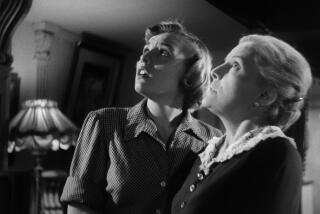NORMA SHEARER WEEK AT THE MELNITZ
Norma Shearer is best remembered as the lovely wife who must compete with Joan Crawford, her husband’s hard-as-nails mistress, in “The Women” (1939).
Yet Shearer, a box-office favorite in the ‘20s and ‘30s who died in 1983, was almost literally the queen of Metro-Goldwyn-Mayer. This week at Melnitz Theater, UCLA Film Archives will present three films in which Shearer appears in varying degrees of prominence, all part of the continuing “MGM: The Silent Twenties” series.
She is the star of “The Devil’s Circus” (1926), Ramon Novarro’s leading lady in “Old Heidelberg” (1927) and a featured player in “Pretty Ladies” (1925) in a part so small that if you blink you’ll miss her. The film marked Joan Crawford’s film debut as a diamond-in-the-rough hoofer.
The first screens at 6 p.m. Thursday; the last two screen as a double feature at 8. All will be accompanied by organist Robert Israel.
These three handsome pictures could scarcely be more different. In “The Devil’s Circus” and “Old Heidelberg” Shearer radiates an endearing innocence and gallantry.
Over the 15 years of her stardom, highlighted by “The Barretts of Wimpole Street,” “Romeo and Juliet” and “Marie Antoinette,” she evolved from a pretty young woman into a chic, patrician beauty.
Born in Montreal at the turn of the century, Shearer broke into the movies in 1920. She seemed to lose interest in her career after the 1936 death of husband Irving Thalberg, MGM’s legendary executive producer, but remained a durably elegant figure on the Hollywood scene into the ‘60s.
“The Devil’s Circus” is heavy with the Victorian melodrama of so many silents yet is still enjoyable thanks to the sophistication and rich pictorial sense of noted Danish director Benjamin Christianson.
In Christianson’s view, humans are but puppets at the mercy of the devil. Yet there is the possibility of redemption through love and faith in God. Somewhere in Europe just before World War I, an innocent country girl (Shearer) and a city slicker (Charles Emmet Mack), disarmed by her virtue, become menaced by the suave, diabolical lion tamer (John Miljan) at a circus where Shearer has sought work. In attracting Miljan’s attention, Shearer incites the jealousy of the star of the show (Carmel Myers).
“Old Heidelberg” is adapted from the same 1902 play as Sigmund Romberg’s 1924 operetta “The Student Prince” and has been rendered timeless and remarkably poignant by director Ernst Lubitsch’s famed touch.
Just as Lubitsch made a triumph without words of “Lady Windermere’s Fan,” he’s done the same with “Old Heidelberg” minus the familiar Romberg music. A classic love-versus-duty conflict arises as a handsome young Ruritanian prince (Ramon Novarro) falls in love with a hearty Fraulein (Shearer), a waitress at the Heidelberg inn where the prince has taken rooms with his avuncular tutor (Jean Hersholt).
So sophisticated a film maker was Lubitsch that his film is free of the schmaltz and dated quality of the musical versions.
“Pretty Ladies,” directed by the largely forgotten Monta Bell, is a snappy backstage story.
The star of “Pretty Ladies” is Zasu Pitts, cast as an Irish counterpart to Fannie Brice, a Broadway revue star comedienne. Brice never lands the guy until she strikes up an acquaintance with the show’s drummer (Tom Moore). Her success with Moore only brings him to the attention of the revue’s temperamental, ruthless glamour girl (Lilyan Tashman).
Information: (213) 825-2581, 206-8170.
More to Read
Only good movies
Get the Indie Focus newsletter, Mark Olsen's weekly guide to the world of cinema.
You may occasionally receive promotional content from the Los Angeles Times.










